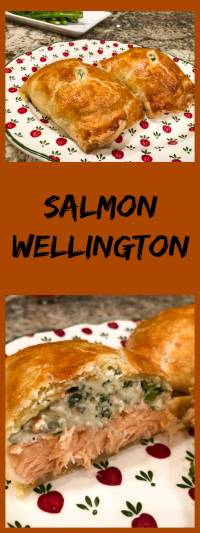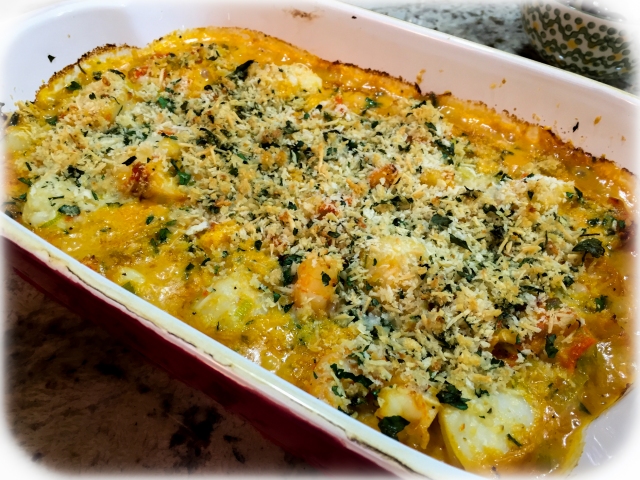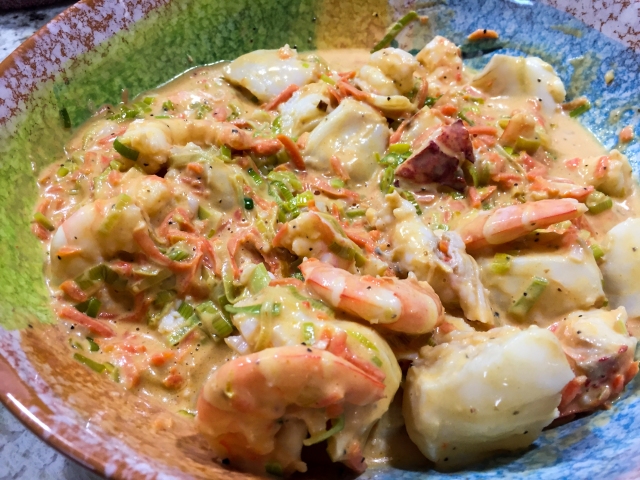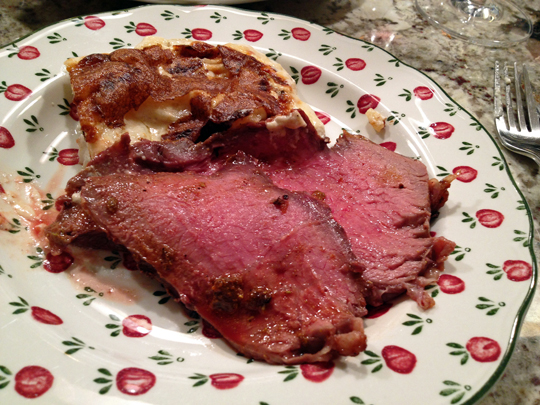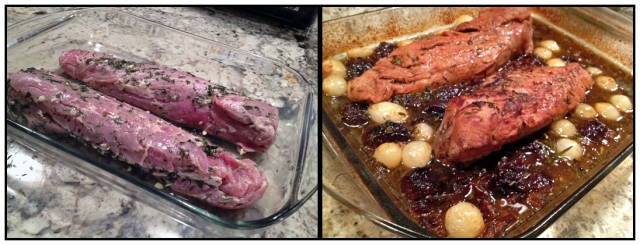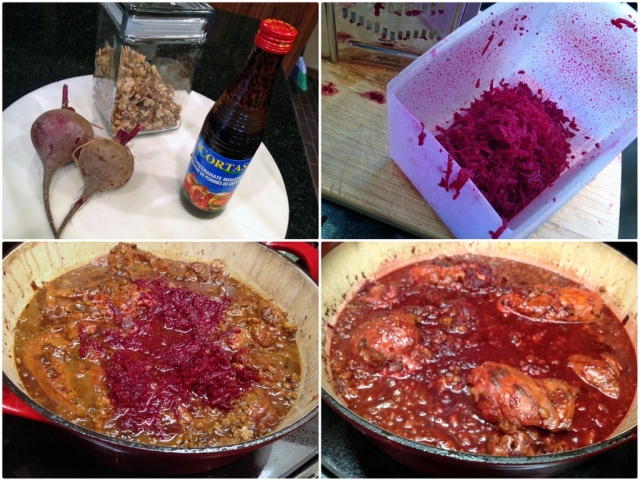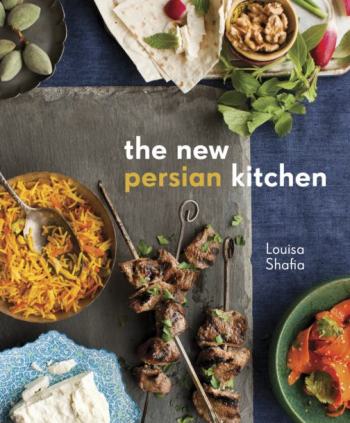
You know you’ve been blogging for a while when you got more than one recipe for Salmon Wellington… My previous take is pretty much our default method, because using phyllo dough considerably reduces the richness of the dish. We make it regularly. It is interesting how once you keep making a recipe that seems quite involved at first, it becomes so easy to prepare you act as if it’s just like grilling a steak. First weekend of the year (with Salmon Wellington in my mind), I asked Phil if he had any particular recipe he’d been craving. I could not believe my ears when he picked it, almost instantaneously. That’s when fate worked against us. We could no find phyllo dough at our store. Only phyllo cups. Drove to store number 2. No luck. Plenty of boxes of phyllo cups, empty shelf where the sheets would be. In despair, drove to Wal-Mart, a place I almost never visit. No cigar. Once you have a craving, you have a craving. Puff pastry it would be. And since we started messing up with our classic, I changed a few more things and here I am to share this new version with you. It turned out excellent, and it might take the default spot for a while… An extra session of aerobics and we’ll be fine.
SALMON WELLINGTON
(from The Bewitching Kitchen)
3 pieces of salmon filet, about 6 ounces each)
salt and pepper to taste
1 tablespoon grapeseed or olive oil
1 large stalk celery, minced
1 shallot, minced
1/2 cup cooked crab meat, shredded (from 2 small crab legs)
Freshly squeezed lemon juice to taste
1/2 block cream cheese, at room temperature
minced fresh cilantro, to taste
1 sheet of puff pastry, defrosted in the fridge for several hours
flour to roll out the pastry
egg wash made with 1 egg, 1 tsp water and a pinch of salt
Heat oven to 375 F (see notes).
Prepare the topping by sauteing the celery and shallot pieces in olive oil over medium heat. Season with salt and pepper. When all soft and translucent, transfer to a small bowl to cool down slightly. Add the cream cheese, lemon juice, shredded crab meat and fresh cilantro, mix all gently but well and reserve. Adjust seasoning with salt and pepper.
Roll out the puff pastry over a counter top lightly dusted with flour. Try to get it really thin, ideally one sheet should be enough to wrap three small salmon filets. Place the salmon filet over it, make sure it is dry, blot it with paper towels if necessary. Season with salt and pepper. Place a good portion of cream cheese mixture on top. Wrap the filets with the dough. I actually found it easier to flip the pieces after the photo was taken, so that the filling is on top, and the edges of the pastry meet at the bottom of the parcel.
Cut a slit in the center of the packages. Brush with egg wash. Bake for about 22 minutes, until the pastry is golden. Let it cool slightly and serve.
ENJOY!
to print the recipe, click here
Comments: A few pointers for success. First, if your pieces of salmon are not uniform in thickness, simply fold the thinner part underneath the piece, to prevent it from getting over-cooked and dry. Second, roll the puff pastry as thin as you can without tearing it or making it too hard to wrap around the filets. One sheet of puff pastry (Pepperidge Farm in the brand I got) will be enough to wrap three small filets of fish. Third, do not bake for more than 25 minutes, so that your salmon will still be moist and flavorful. With the pastry rolled thin, it will be long enough to fully bake it. The fish will be perfect inside, protected by the nice layer of crab and cream cheese mixture.
We enjoyed two of these babies at dinner, and next day shared the third one for lunch. I am very picky about eating leftover salmon, rarely find it tasty. This time was an exception, we placed it in the microwave for 2 minutes, to jump-start heating from the center, then immediately transferred it to our small oven at 400F. Worked great, the meat was still perfectly cooked and moist.
This would be a perfect dish for entertaining, as you can assemble it all in advance. When it’s time to eat, place in the oven and get the side dishes ready. Your guests will be impressed, I am sure… And let’s not even forget that Valentine’s Day is coming up fast… Salmon Wellington followed by a little chocolate lava cake sounds like a dream come true. Although we all know that real dreams are made of macarons…
NOTE ADDED AFTER PUBLICATION: A reader made this recipe and found that cooking at 400F works better because the puff pastry will benefit from it. If you shorten the time to 21 minutes in the oven, you won’t have over-cooked salmon and the puff pastry will be gorgeous. So consider that change. Thanks blackbird for the feedback…
Dinner is served!
Salmon Wellington, buttered asparagus, fresh oysters, a little Caesar salad…
ONE YEAR AGO: The Unbearable Unfairness of Cake Baking
TWO YEARS AGO: Hermit Cookies
THREE YEARS AGO: Cremini Mushroom Meatloaf
FOUR YEARS AGO: Ottolenghi & Tamimi’s Roast Chicken with Clementines
FIVE YEARS AGO: Eight-Ball Zucchini: The Missing Files
SIX YEARS AGO: Grilling Ribbons
SEVEN YEARS AGO: Peppery Cashew Crunch
EIGHT YEARS AGO: Ossobuco Milanese: an Italian Classic




